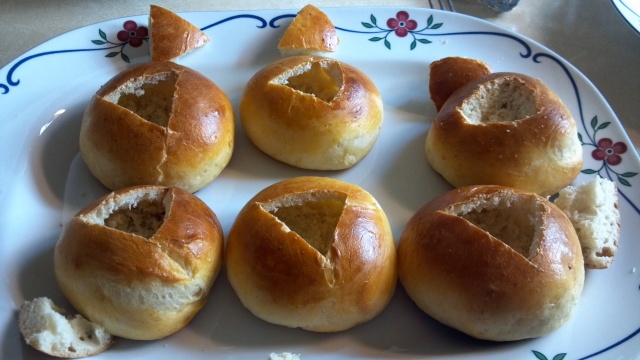Well my friends, once again, it is Mardi Gras, Fettisdagen, or Fat Tuesday – whichever moniker you prefer! Back in the day, that meant that this was the last day of Shrovetide, and your last chance to gorge yourself on various protein rich delicacies in anticipation of Lent – a 40-day stretch of fasting. I think it’s fair to say that we’ve grown a little soft in our resolve since then, but Fat Tuesday is still a great time for young and old to pig out.
In Sweden, the treat of choice on this special day is the Semla – a marvelous kardamom wheat bun filled with almond paste and whipped cream – often served swimming in warmed milk. Sooo yummy! The name Semla is derived from the Latin word for fine wheat flour – simila. Cooks might also recognize ‘semolina’ in there as the finest of all the wheat varieties. These buns were far different from coarser fare of rye and barley. This kind of fine, expensive flour – where available – was reserved only for celebrations and holidays, and certainly more common in society’s upper echelons than in the humble kitchens of farming culture.
While the roots of the bun consuming tradition reaches far into antiquity, the Semla is said to have arrived in Sweden via Germany. The 18th century Germans enjoyed buns filled with almond paste, which were served in a bowl with warm milk. They called the buns “Heisse Wecke” which translates to “hot wedges”. The wedge lives on in the modern interpretation of these buns, as the shape of the bun’s “lid” is often in the form of a wedge covered in powdered sugar.
On February 12, 1771, the Swedish king Adolf Fredrik collapsed after a massive meal of nearly Roman proportions. Later, he was said to have died from eating too many semlor. In reality he suffered either a stroke or cardiac arrest, but no matter – it gave the Semla a bad rep, and a contemporary poet by the name of Johan Gabriel Oxenstierna indignantly suggested it be banned, since it had indeed caused the death of a king. However, the love for these delectable buns remained. By the early 1900’s, they were made with the white flour, the almond paste and the whipped cream we recognize to this day.
They are pretty easy to make. For the dough, use the same recipe as for Swedish Cinnamon Rolls. Instead of twisting the dough into knots, simply roll the dough into 2.5” rolls. Easy-peasy…

Cut a wedge out of the top of the roll. Scrape out as much of the interior as you can with a fork, without puncturing the wall. Collect the scrapings in a bowl.

Top with whipped cream, and plunk the wedge back on top. Use a tea strainer to coat the buns in powdered sugar. If you are feeling ambitious, by all means use a cake decorating tube to apply the cream. I’m usually too lazy, but it truly looks much more professional. Tastes the same, though…
There! You’re done! Heat up some milk, and serve in a bowl with a spoon. Or, eating it like the little girl in the picture is fine too, if you prefer it that way. Either way, it’s yummy. Enjoy!










Oh My! Fatten up is right! These look delectable. It’s interesting how so many Christian cultures each have their own Shrove Tuesday treat.
Yeah, no wonder Adolf Fredrik caved under the calorie load. He reportedly LOVED these, and ate them with abandon and gusto! And I can see why… They are really, really good!
So much fattier and yummy than the pancake day in the Uk !
But Pancake Day sounds pretty darn yummy too! 🙂 When is it?
I’m not much of a baker, but these look well worth the effort.
You’ll probably find that they are pretty easy. 🙂 I usually make the dough the night before, so it has time to rise properly. After you roll them, they will have to sit again for a couple of hours before you bake them, so having that first step out of the way is nice. Good luck!
Oh, these look wonderful. And I think simmered milk is one of the best fragrances ever.
So true! Softened by the warm milk, this is truly balm for the soul (and padding for your hips). 🙂
Pingback: Whippings, weather and witches – and other superstitions relating to Swedish Easter traditions. | The Creative Flux
I think I am going to switch to your method of letting them rise over night. The buns I proofed for 2 hours according to the other recipe I had did double in size, but they were too flat. Looking forward to trying your recipe!
Yeah, I have found that they do that if it’s too warm. I like splitting it up over a couple of days because not only is the result better – it also feels like less of a time commitment. These things only get better if given the time. 🙂